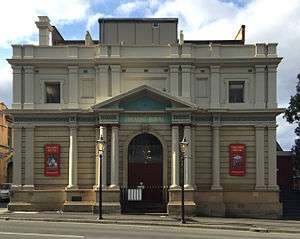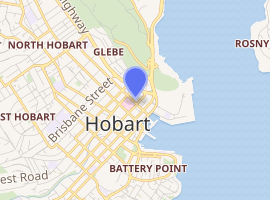Theatre Royal, Hobart
Theatre Royal is a historic performing arts venue in central Hobart, Tasmania. It is the oldest continually operating theatre in Australia; Noël Coward once called it "a dream of a theatre"[2] and Laurence Olivier launched a national appeal for its reconstruction in the 1940s.[3]
 The Theatre Royal exterior in 2015 | |

| |
| Address | 29 Campbell Street, Hobart 7000 Hobart, Tasmania Australia |
|---|---|
| Coordinates | 42.8796°S 147.3311°E |
| Owner | Theatre Royal Management Board |
| Designation | Listed building |
| Capacity | 698[1] |
| Production | Ballet, opera, drama, repertory |
| Construction | |
| Opened | 1837 |
| Rebuilt | 1837, 1850s, 1890s, 1986 |
| Years active | 1834–1984 1986 – present |
| Architect | John Lee Archer |
| Website | |
| www | |
History
1834–1856, Construction and early years
In 1834, Peter Degraves, founder of Cascade Brewery, and a group of Hobart citizens purchased dock-side land for the purpose of building a public theatre. Architect John Lee Archer created a provincial Georgian design and the first stone was laid that year.[4][5] The location was not ideal for future gentry audiences; it was in a rough and foul-smelling area near an abattoir, brothels, factories, and pubs.[2] The architect accommodated the local population by creating an entrance through a neighbouring pub directly into the theatre's pit seating, colloquially known as "the Shades." When a national economic downturn caused most of the original investors to pull out, Degraves stepped in and took complete ownership.
The building was completed, using convict labor in part, by the end of 1836. It staged its inaugural performances in March 1837; Thomas Morton's Speed the Plough and the W. Oxberry's The Spoiled Child. In June, the theatre was formally named the "Royal Victoria Theatre" in honor of the coronation of the Queen of England but it became known simply as "The Theatre Royal."[3][6]
During the period of Anne Clarke's tenure as manager (1840-1847), the theater became renowned as a pioneer theater institution in Australia for its high quality and Clarke was credited by the press with introducing 'a better class of performer and a superior style of management' and for giving theater, which was then regarded as somewhat dubious, a good name.[7]
1856–1911, Cockfights etc
Due to the neighbourhood, early performances tended towards cockfights, boxing, and religious meetings. The patrons of the Shades included visiting seamen and workers from the convict-laden Wapping area surrounding the theatre. They became known for their drunken and disruptive interactions with performers.[5][8] Degraves undertook a major renovation in 1856 but it didn't improve bookings or offerings. Following Degraves' death in 1883, Richard Lewis purchased the theatre for £3222. For the next 40 years or so, Lewis made improvements to further attempt to upgrade the theatre's fashion. In 1911 the interior was completely rebuilt, creating the Louis Quatorze style auditorium there today. Designed by William Pitt from Melbourne, who specialised in theatres, the Shades was replaced with raked stalls seating, and a higher and steeper balcony was built above. The decoration featured red velvet upholstery, gilded highlights, and a crystal chandelier in a domed ceiling.[9]
1911–1952, Decline and first major renovation
Despite continued attempts at maintaining the theatre, it declined over the next 3 decades. By the 1940s, the performers had to beware of holes in the stage, unsafe wiring, faulty heating, and cockroaches. Unsafe conditions eventually led to a planned demolition.[2] In 1948, Sir Laurence Olivier arrived in Hobart as part of the Old Vic touring company and spoke passionately about the theatre, launching a national appeal;
"We appreciate playing in it not only because it is a beautiful little theatre; it is more than that. Your parents and grandparents have sat here as audience. Our parents have acted on this stage. In the one hundred and eleven years it has been played in it has built up atmosphere and the secret of atmosphere is antiquity. Don’t let it go."[3]
His speech was effective. The state government purchased the theatre for £12,000 with the promise of restoration if matching funds were raised. An ambitious public campaign followed and by 1952, the renovations were completed. 'Royal boxes' had been installed specifically for an anticipated visit from then-Princess Elizabeth. King George's death curtailed the planned audience but the theatre re-opened on schedule. The updates were a success; the theatre was booked with frequent productions and became home to a new resident company.[10]
1952–1986, Expansion and fire
The theatre enjoyed several successful decades marked with periodic structural updates. In the early 1980s, a A$1 million-dollar refurbishment was launched in honor of the theatre's 150-year anniversary. In addition to restoring much of the 1911 decorations, the backstage facilities were modernized and reconfigured to become the Backspace Theatre, a venue for cabaret and smaller local companies. The work was almost complete when, on 18 June 1984, a fire began backstage and spread to the main auditorium. In addition to structural damage to the roof, the water and smoke damage was extensive but was somewhat contained by a fire curtain that somewhat inexplicably fell across the stage. Most of the furniture, decoration, and technical equipment was damaged; only one painting survived. 'Australia's grand old lady of the theatre world' was quickly launched back into reconstruction, covered by a public fundraising appeal, adequate insurance and the State Government's assurance. However, it would take several years for the theatre to re-open.[10][11][12]
1986–Current
The theatre completed its major refurbishment and reopened in March 1986. It re-established itself as a centre of Hobart's social life, thanks in part to government policies encouraging national touring of popular theatre shows. It presents an annual program that features live theatre, contemporary music, dance and entertainment. Since 1994, it has offered a subscription season and has seen both the number of performances and overall attendances increase steadily. The theatre has incorporated modern technology with the computerisation of the lighting control system and the installation of a computerised ticketing system.[2][3]
Fred the Ghost
The theatre's mascot is a resident ghost of a former actor who was allegedly killed during a fight in the basement. Known as "Fred", the theatre used the ghost for the first time in the 1948 restoration appeal.[2][12]
References
- "THEATRE ROYAL, HOBART HIRE CHARGES AND VENUE DETAILS" (PDF). Retrieved 24 May 2013.
SEATING CAPACITY Maximum Seating Capacity is 69 8 made up as follows; Sta ll s 337 (includes 2 wheelchair positions) Dress Circle 174 Gallery 187 698
- "History of the Theatre Royal". Theatre Royal, 29 Campbell St Hobart. Retrieved 24 May 2013.
- "Australia's Oldest Theatre The Hobart Theatre Royal" (PDF). Australian Heritage. Australia's Heritage Publishing G.P.O. Box 5390 Sydney NSW 2001: Heritage Australia Publishing. Spring 2009. pp. 10–11.CS1 maint: location (link)
- Thorne, Ross (June 1977). "Hobart's Historic Theatre Royal" (PDF). Theatre Australia. Vol. 2 no. 2. Playhouse Press Pty Lt. pp. 16–19. Retrieved 24 May 2013.
- Alexander, Alison (2006). "Theatre Royal". The Companion to Tasmanian History. University of Tasmania Private Bag 81 Hobart, Tasmania 7001 Australia: Centre for Tasmanian Historical Studies, University of Tasmania. Retrieved 24 May 2013.CS1 maint: location (link)
- McIntyre, Paul (3 November 2009). "3 November, 2009 12:55PM AEDT The Theatre Royal celebrates 175 years". ABC.net. Retrieved 24 May 2013.
- E Webby, 'Anne Clarke', in P Parsons (ed), Companion to theatre in Australia, Sydney, 1995.
- Roe, Margriet (1966). "Hayes, Sir John (1768–1831)". Australian Dictionary of Biography. Melbourne University Press. ISSN 1833-7538. Retrieved 20 August 2009 – via National Centre of Biography, Australian National University.
- "THE THEATRE ROYAL". The Mercury. XCVI (12, 983). Tasmania, Australia. 4 November 1911. p. 10. Retrieved 4 July 2019 – via National Library of Australia.
- Ross, Andrew (September 1998). "Theatre Royal, Hobart". Tasmanian Year Book, 1998. Australian Bureau of Statistics. Retrieved 24 May 2013.
In 1948, the Old Vic Company toured to Hobart with Laurence Olivier and Vivien Leigh, who were in part responsible for motivating public opinion towards saving the theatre. A successful fundraising campaign enabled restoration. The building was purchased by the State of Tasmania, and the early 1950s witnessed the Theatre Royal's re-emergence as a major social centre in the city. This was to be crowned in 1952 by a visit from the-then Princess Elizabeth, but en route to Australia, she was called back to England to become Queen following the death of George VI. Nonetheless, the number of productions increased and a resident company even offered subscription seasons. More work in the 1970s modernised the backstage facilities and created space that was, in the mid-1980s, to become the Backspace Theatre, a popular and affordable performance space for cabaret and smaller local companies. In 1984, the auditorium was again renovated, this time to return its colour to the deep burgundy of the early 1900s. The work was almost complete when disaster struck and the theatre was extensively damaged by fire. The future looked grim, but again the generosity of the public, corporate donors and the State Government ensured that Australia's grand old lady of the theatre world was saved.
- "Hobart's Theatre Royal was almost ready for its birthday; Fire not last act for treasured theatre". Sydney Morning Herald. 19 June 1984. Retrieved 24 May 2013.
- Martain, Tim (12 July 2012). "Hobart's most haunted". The Mercury (Newspaper). Davies Brothers Pty Ltd. Retrieved 24 May 2013.
He is blamed for occasional cold chills and slamming doors around the theatre and in 1984 received credit from some for saving the Theatre Royal from a potentially devastating fire. The blaze was prevented from spreading and gutting the entire building only by a fire curtain that mysteriously dropped across the stage when nobody was in the building.